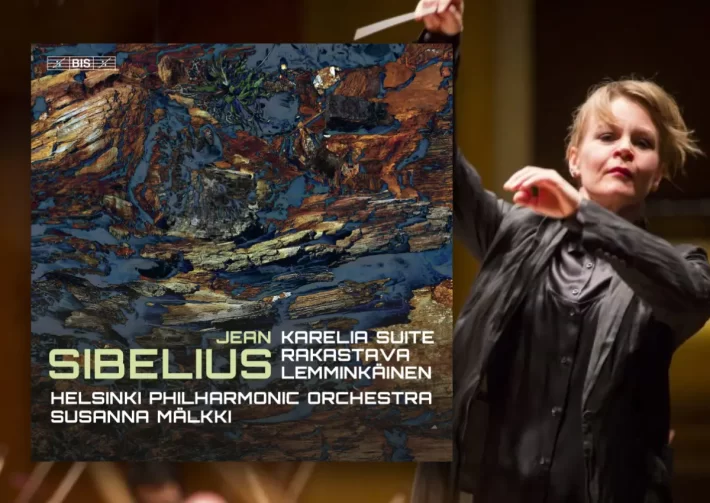The three works presented here are part of Sibelius’s early era and share an interesting commonality: each was revised, some multiple times (there are at least 5 reincarnations of Rakastava with different arrangements of voice and instrumentation).
Sibelius wrote the Op. 11 Karelia Suite as a musical montage of the region bearing the same name. The interludes that bookend the Intermezzo (track 1) give off Wagnerian vibes with rustling strings and horn calls; the Helsinki Philharmonic brass, well-balanced and mellow, creates a pleasing yet optimistic sound for the spirited middle section. As an earlier work, we can hear a sort of scrappy compositional style but one that no doubt captures a folk-like character.
The Ballade (track 2) reflects the structure of the Intermezzo not in terms of form but, more intriguingly, in instrumentation: as the brass section was spotlighted at the start and end, now it’s the woodwinds’ turn. The Helsinki players again have a lovely, blended sound, though I would have liked to hear more of the clarinet’s melodic line pierce through—something Okku Kanu/Helsinki Radio Symphony’s recording does successfully through slightly drier articulation.
I did, however, like how the bassoon’s contrapuntal phrases come through to create an interesting juxtaposition against the otherwise hymn-like texture (this is helped by BIS’ outstanding SACD recording). Speaking of counterpoint, the low strings deserve kudos for creating clean lines that help fuel a momentum which is key to the sweeping nature of the middle section.
Related Posts
- Review: Ammann, Ravel, Bartók – Piano Concertos – Haefliger, Helsinki Philharmonic Orchestra, Mälkki
- Review: Bartók – Concerto for Orchestra and Music for Strings, Percussion & Celesta – Mälkki
- Review: Sibelius – Complete Symphonies – Klaus Mäkelä, Oslo Philharmonic
Although the Op. 14 Rakastava was written just a year after Karelia, the final 1912 revised version (performed here) shows us developments in Sibelius’ orchestration. In The Lover (track 4), for instance, emotions come through via extremes in registrations. Mälkki and the ensemble highlight this dichotomy by leaning into the respective parts; what we get is a bold, vibrant sound that embodies poignancy and yearning.
Compositionally, In the Path of His Beloved (track 5) speaks to a degree of excitement which doesn’t always get a noticeable response from this performance; The scurrying strings are clear as a bell, but the anticipation feels too nuanced and doesn’t seem to arrive to its desired destination. Osmo Vänska and the Lähti Philharmonic (also on BIS) have a much more effective account that derives energy from more significant variations in dynamics and better architecture of the buildup. Good Evening! (track 6), though, is beautifully done. The solo string voices intertwine, creating an interplay between several personalities: we have the coy charm (1’27”) and giddiness (1’40”) of the ‘Good Night’ that gives way to an almost tragic ‘Farewell’ created by the groans of the low strings and a mournful cello solo.
In a letter to his wife Aino, Sibelius wrote of how he felt a closeness to the music of Liszt, specifically his symphonic poems. It would come as no surprise that Sibelius would then write such a poem of his own: the Op. 22 Lemminkäinen. Like the other two works, it is steeped in the Finnish literary tradition. Again, we can hear the composer’s continued growth in his use of textures and colors to capture the narrative. The central character, as the very well-written liner notes describe, is a swashbuckling hero whose indomitable spirit comes through in the chattering winds of the first movement (track 7). It is in the latter parts, however, that we hear the orchestra at its best as it boasts a truly panoramic sound. Perhaps the most famous movement is The Swan of Tuonela (track 8) whose darkness, mystery, and poignancy draw the listener into a world of introspection. The violins have an air of fragility about them, which makes the meandering wind and string solos all the more salient yet wistful.
While there are some more vibrant performances of some of these selections out there, Mälkki and the Helsinki players do fine work across the board. Curation-wise, a program of this sort featuring early works is both interesting and important to understanding a composer’s musical trajectory—and this album has shed light convincingly on Sibelius’ creative spirit.

Sibelius – Early Orchestral Works
Helsinki Philharmonic Orchestra
Susanna Mälkki, Conductor
BIS, SACD Hybrid 2638
Recommended Comparisons
Karelia – Ashkenazy & Philharmonia Orchestra | Rakastava – Vänska & Lähti Symphony | Rakastava – Gibson & Scottish National Orchestra | Lemminkäinen – Järvi & Royal Stockholm Philharmonic
Included with an Apple Music subscription:
Read more classical music reviews or visit The Classic Review Amazon store
Follow Us and Comment:
[wd_hustle id=”HustlePostEmbed” type=”embedded”]











